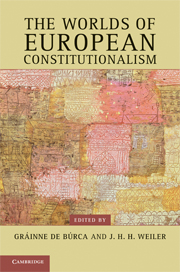Book contents
- Frontmatter
- Contents
- Contributors
- Introduction
- Prologue: global and pluralist constitutionalism – some doubts
- 1 The European Union as an international legal experiment
- 2 The place of European law
- 3 The ECJ and the international legal order
- 4 Local, global and plural constitutionalism
- 5 The case for pluralism in postnational law
- Dialogical epilogue
- Bibliography
- Index
3 - The ECJ and the international legal order
a re-evaluation
Published online by Cambridge University Press: 05 June 2012
- Frontmatter
- Contents
- Contributors
- Introduction
- Prologue: global and pluralist constitutionalism – some doubts
- 1 The European Union as an international legal experiment
- 2 The place of European law
- 3 The ECJ and the international legal order
- 4 Local, global and plural constitutionalism
- 5 The case for pluralism in postnational law
- Dialogical epilogue
- Bibliography
- Index
Summary
Introduction
The central role of the European Court of Justice in the process of ‘constitutionalizing’ EU law, whereby the Court has deemed certain provisions of EU law to be an integral and directly enforceable part of the law of the Member States, has long generated animated debate amongst EU law scholars. One part of this story which has not always attracted the same degree of attention is the way in which the Court of Justice extended aspects of its constitutionalization strategy to international legal norms. The relative paucity of EU Treaty provisions governing the status and effect of international law in the new European Communities at the time left considerable room for the Court to shape the answer to these questions. In some of its early case-law, the ECJ (European Court of Justice) adopted what has been called an ‘automatic incorporation’ approach to international agreements, deeming them to be part of the EU legal order and their provisions to be enforceable in domestic and EU courts at the suit of individuals. In this way one of the most important sources of international law – international treaties – were from a relatively early stage treated by the Court as a presumptively integral part of the new European legal order. Even if the dimension of this case-law which generated the most extensive commentary was that which subsequently departed from the basic automatic-incorporation approach, namely the Court’s decision to rule out the direct judicial enforceability of the GATT (General Agreement on Tariffs and Trade) and WTO (World Trade Organization) agreements, the general approach of the ECJ to international treaties was to treat them as fully part of the EU legal order and judicially enforceable at the suit of litigants. Further, this embrace of treaties as a central part of the EU legal order was accompanied by what seemed to be a fairly open approach to customary international law as part of EU law. By developing and using a range of doctrinal devices such as the principle of consistent interpretation and the treatment of international legal principles as part of the general principles of EU law, the ECJ exhibited an attitude of notable openness towards international law. In all, its approach to international legal obligations appeared to be one of engagement and loyalty, with the Court positioned as an agent to ensure compliance on the part of the EU and its Member States with the EU’s international obligations. This picture of the ECJ as a faithful enforcer of international legal obligations meshed well with the more general self-image promoted by the EU of an organization devoted to the international rule of law, whose international profile was defined in significant part by this distinctive commitment to international law and institutions.
- Type
- Chapter
- Information
- The Worlds of European Constitutionalism , pp. 105 - 149Publisher: Cambridge University PressPrint publication year: 2011
- 6
- Cited by



